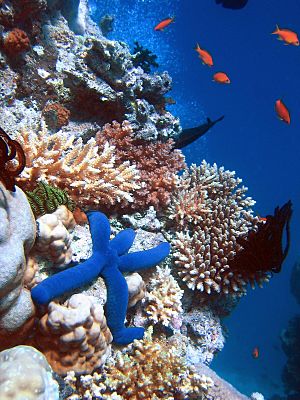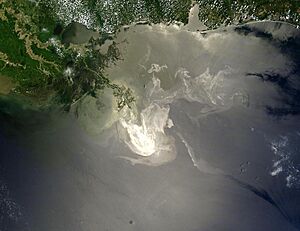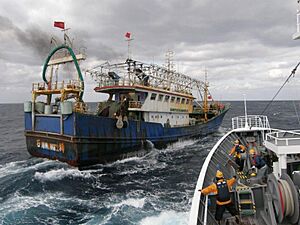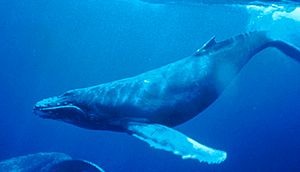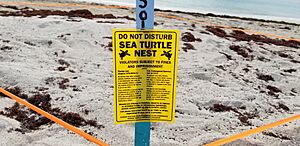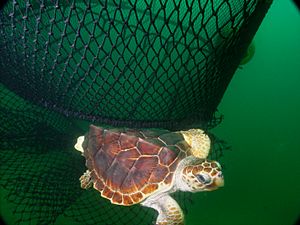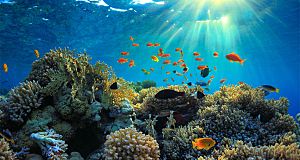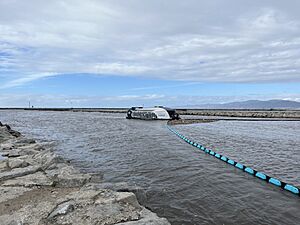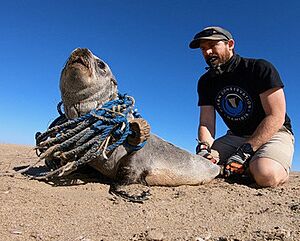Marine conservation facts for kids
Marine conservation, also known as ocean conservation, is all about protecting the amazing plants and animals that live in our oceans and seas. It's like taking care of a giant underwater garden! The goal is to manage how we use ocean resources so we don't use them up too quickly.
This field helps stop problems like species disappearing, ocean homes getting damaged, and changes in how ocean ecosystems work. It focuses on fixing harm caused by humans, restoring damaged areas, and protecting special or endangered ocean life. Marine conservation is a newer area of study that grew because of big issues like species going extinct and ocean habitats changing.
People who work in marine conservation use ideas from many sciences, like marine biology (the study of ocean life), ecology (how living things interact with their environment), and oceanography (the study of the ocean itself). They also consider human factors like what people need from the ocean, ocean laws, and money matters to figure out the best ways to protect ocean species and their homes.
| Marine conservation | |
|---|---|
| <a href="/wiki/File:Blue_Linckia_Starfish.JPG" class="image"><img alt="Blue Linckia Starfish.JPG" src="//upload.wikimedia.org/wikipedia/commons/thumb/d/d4/Blue_Linckia_Starfish.JPG/264px-Blue_Linckia_Starfish.JPG" decoding="async" width="264" height="198" srcset="//upload.wikimedia.org/wikipedia/commons/thumb/d/d4/Blue_Linckia_Starfish.JPG/396px-Blue_Linckia_Starfish.JPG 1.5x, //upload.wikimedia.org/wikipedia/commons/thumb/d/d4/Blue_Linckia_Starfish.JPG/528px-Blue_Linckia_Starfish.JPG 2x" data-file-width="2048" data-file-height="1536"></a> | |
| Coral reefs have a great amount of biodiversity. | |
| Also known as | Ocean conservation |
| Purpose | Protection and preservation of ecosystems in oceans and seas |
| Focus | Limiting human-caused damage to marine ecosystems, restoring damaged marine ecosystems, and preserving vulnerable species and ecosystems of the marine life |
| Related fields | Conservation biology, marine biology, Ecology, oceanography, fisheries science |
Contents
- How Marine Conservation Started
- Important People in Ocean Conservation
- How Humans Affect Ocean Ecosystems
- Endangered and Extinct Ocean Animals
- Ways to Protect the Ocean
- Technology for Ocean Protection
- Laws and Agreements for Ocean Protection
- Groups Working for Ocean Conservation
- Events and Initiatives for Ocean Awareness
- See also
How Marine Conservation Started
Public interest in ocean life grew a lot after World War II. This was partly thanks to books by Rachel Carson, which helped start a time called the "marine revolution." The United States government also began to support marine conservation by creating protected areas. For example, a wildlife refuge was named after Rachel Carson to honor her work. This refuge protects different habitats like beaches, salt marshes, and rocky coastlines.
However, modern marine conservation really began in the 1970s. New technologies, like computers, allowed scientists to explore the undersea world. During these explorations, they learned important things about how ocean ecosystems change. They discovered that all parts of the ocean are connected.
This new understanding changed how marine conservation worked. People started focusing more on restoring damaged ocean systems and protecting the variety of life in the ocean. In 1972, the Marine Protection, Research, and Sanctuaries Act (MPRSA) was passed. This law allowed the U.S. Environmental Protection Agency (EPA) to control what was dumped in the seas. This act was a big step in bringing ocean issues to public attention in the United States.
In 2009, Sylvia Earle, a famous marine biologist, received a special award. This led to the creation of Mission Blue. Mission Blue aims to set up marine protected areas, called "Hope Spots," all over the world. Over 200 organizations support this effort.
That same year, Sylvia Earle also wrote a book called 'The World is Blue: How Our Fate and the Ocean's Are One'. In this book, she explained how fast and dangerous changes in the ocean could threaten all life on Earth. Sylvia Earle's work was also inspired by Rachel Carson.
In 2010, many scientists, business leaders, and famous people supported Dr. Sylvia Earle's Mission Blue. The next year, a group called Ocean Elders was formed. Their goal is to bring together scientists, governments, and entertainment leaders to protect the oceans.
Important People in Ocean Conservation
- Rachel Carson: A marine biologist, writer, and environmental activist.
- Jacques Cousteau: An explorer, conservationist, researcher, and author.
- Sylvia Earle: A marine biologist, explorer, and author.
- Steve Irwin: A naturalist, conservationist, zoologist, and TV personality.
How Humans Affect Ocean Ecosystems
As the number of people on Earth grows, so does our impact on ecosystems. Human activities have caused many species to disappear, leading to a big drop in the variety of plants and animals in our environment.
These impacts include:
- Too much fishing: This harms coral reefs and leads to overfishing.
- Tourism: The growing tourism industry also puts pressure on marine environments.
- Carbon dioxide (CO2) emissions: Oceans absorb about one-third of the CO2 humans produce. This changes the ocean's chemistry by making it more acidic, a process called ocean acidification. This is very bad for marine life.
- Oil spills: These spills cause ocean pollution and harm marine animals.
- Shipping: Ships can bring new species to different areas, which can take over and harm local ecosystems. Ships can also hit and kill whales.
Coral Reefs: Important Ocean Homes
Coral reefs are like busy cities underwater, full of many different kinds of life. They are super important for the survival of entire ecosystems. Reefs give many marine animals food, protection, and shelter.
Coral reefs also help humans. They provide food like fish and shellfish. They are also popular places for ecotourism, which helps local economies. Scientists are even studying corals to find new medicines.
Sadly, human actions are damaging coral reefs more and more. The biggest threats are overfishing, harmful fishing methods, dirt washing into the ocean, and pollution from land. Along with more carbon in the oceans, coral bleaching, and diseases, this means there are almost no untouched reefs left. Up to 88% of coral reefs in Southeast Asia are now at risk. This directly affects the many species that depend on them.
This is especially hard for island nations like Samoa, Indonesia, and the Philippines. Many people there rely on coral reefs for food and their jobs. But because there are fewer fish, some fishermen use harmful methods like cyanide and dynamite for fishing. This further damages the reefs and makes the problem worse. One way to stop this is by teaching local communities why protecting coral reefs is so important.
Overfishing: Taking Too Many Fish
Overfishing is a main reason why the number of ocean animals has dropped in recent years. The Food and Agriculture Organization of the United Nations reported that the percentage of the world's fish stocks that are at healthy levels went down from 90% in 1974 to 65.8% in 2017. Taking too many fish from these large fisheries harms the ocean environment. It also threatens the lives of billions of people who depend on fish for food or income.
According to the World Wildlife Fund, illegal, unreported, and unregulated fishing is a big part of overfishing. Illegal fishing is thought to make up to 30% of the catch for some valuable fish. This illegal industry is estimated to be worth $36 billion each year.
Too Many of One Species
Sometimes, one species can grow too much, either naturally or because humans can't control it. When one species takes over, it can upset the balance in an ecosystem. This can lead to other species dying off and the habitat being harmed. This usually happens with invasive species.
New Species in New Places
International shipping has caused many marine species to spread far from their native homes. Some of these new species can cause problems. For example, the North Pacific seastar was brought to Tasmania, Australia, and caused issues. Organisms can travel by sticking to ship hulls, in ballast water (water ships take on for balance), or from water dumped from home aquariums. A single tank of ballast water can contain about 3,000 non-native species. Once a new organism settles in an ecosystem, it's very hard to get rid of it.
The San Francisco Bay is one of the places most affected by foreign and invasive species. According to the Baykeeper organization, 97% of the organisms in the San Francisco Bay have been affected by the 240 invasive species brought into the ecosystem. Invasive species like the Asian clam have changed the food web by reducing the number of native species like plankton. The Asian clam also clogs pipes and blocks water flow in power plants. Their presence in the San Francisco Bay has cost the United States about one billion dollars in damages.
Endangered and Extinct Ocean Animals
Marine Mammals
Baleen whales were hunted a lot from the 1600s to the mid-1900s. They were close to extinction when a worldwide ban on commercial whaling started in 1986. The Atlantic gray whale, last seen in 1740, is now extinct because of whaling.
Since the 1960s, the number of monk seals around the world has been quickly dropping. The Hawaiian and Mediterranean monk seals are considered some of the most endangered marine mammals on Earth. The Caribbean monk seal was last seen in 1952 and is now confirmed extinct. The vaquita porpoise, discovered in 1958, has become the most endangered marine species. More than half of its population disappeared since 2012. The vaquita often drowns in fishing nets used illegally in marine protected areas off the Gulf of Mexico.
Sea Turtles
In 2004, a group called the Marine Turtle Specialist Group (MTSG) found that green turtles were endangered worldwide. Data showed that over the last 100–150 years, there has been a 48–65% decrease in the number of adult female green turtles nesting.
The Kemp's ridley sea turtle population dropped sharply in 1947. At that time, 33,000 nests, which was 80% of the population, were collected and sold by villagers in Mexico. By the early 1960s, only 5,000 individuals were left. In 2015, the World Wildlife Fund and National Geographic Magazine named the Kemp's ridley the most endangered sea turtle in the world.
Fish
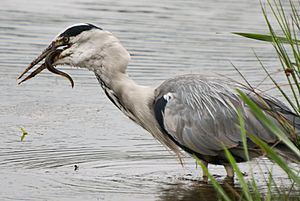
In 2014, the IUCN changed the Pacific bluefin tuna's status from "least concerned" to "vulnerable" on the extinction risk scale. This tuna is mainly caught for sushi. A study in 2013 showed that the Pacific bluefin tuna population dropped by 96% in the Pacific Ocean. Also, 90% of the Pacific bluefin tuna caught are young fish that have not yet reproduced.
Between 2011 and 2014, the European eel, Japanese eel, and American eel were added to the IUCN red list of endangered species. In 2015, the Environmental Agency found that the number of European eels had dropped by 95% since 1990. An officer who has studied eels for 20 years said, "There is no doubt that there is a crisis."
Marine Plants
Johnson's seagrass is a food source for the endangered green sea turtle. It reproduces without a partner, which limits its ability to spread and grow in new places. This seagrass was once the only marine plant listed as endangered. In 1998, it was given protection. However, it is now known to be a clone of a common plant called Halophila ovalis, so its protection was removed.
There isn't much data on this plant, but it's known that its numbers have dropped by 50% since the 1970s. Many things cause this decline, such as poor water quality, careless boating, and anchoring. Also, hurricanes caused by climate change increase the risk of its extinction.
Ways to Protect the Ocean
Strategies for marine conservation often combine scientific ideas, like how animal populations grow, with practical actions. One common action is setting up protected areas, like marine protected areas (MPAs). These areas aim to limit the harm caused by human activities.
These protected areas work in different ways. Some have seasonal closures, others are permanently closed, and some have different zones for different activities. For example, some zones might have speed limits for boats, while others might be "no-take" zones where fishing is not allowed. Other methods include creating sustainable fisheries and helping endangered species grow their populations using artificial means.
Another focus for conservationists is stopping human activities that harm ocean ecosystems or species. This is done through policies, like fishing quotas (limits on how many fish can be caught), or laws. It's also important to understand the economic side of how humans use ocean ecosystems. Educating the public about conservation issues is key, especially tourists who might not know the rules for a marine habitat.
For example, a project called Green Fins in Southeast Asia works with the scuba diving industry to teach people. This project encourages scuba diving operators to teach their students about marine conservation. They also encourage divers to explore in a way that doesn't harm coral reefs or other ocean ecosystems.
Scientists divide the conservation process into several parts. For marking and capturing animals, common methods include ways to safely hold seals and chemical methods to calm them. For whales and dolphins, there are ways to capture and release them. Recently, new methods include using remote sensing to study how coastal ecosystems are affected by river floods, and advanced imaging.
Many social science methods are also used. Researchers have found that social events can help marine conservation. They encourage sustainable tourism to make people more aware. They also suggest combining traditional ways of managing resources with modern conservation. They point out that differences between these two approaches have sometimes led to failed efforts. Others suggest combining marine conservation and tourism, as setting up conservation areas can help reduce conflicts.
Dividing protected areas into zones helps group similar activities together and separate those that don't mix. Common ways to get the public's attention include teaching about the carbon footprint and encouraging people to make sustainable food choices and use less plastic.
Technology for Ocean Protection
Marine conservation technologies help protect endangered ocean animals and their homes. These new technologies are important because they reduce the number of unwanted animals caught by accident (by-catch). They also help marine life survive and stay healthy, and they can even benefit fishermen.
Examples of these technologies include:
- Marine protected areas (MPAs): Designated areas where human activities are limited to protect marine life.
- Turtle excluder devices (TEDs): These devices help sea turtles escape fishing nets.
- Autonomous recording units: Devices that record sounds underwater.
- Pop-up satellite archival tags (PSATs): These tags track the movements of large marine animals.
- Radio-frequency identification (RFID): Used to identify and track animals.
For marine conservation to work, it's important that these technologies are practical for commercial use. This means they need to meet the needs of fishermen while also protecting marine life.
PSATs are very important in marine conservation. They allow marine biologists to study animals in their natural environments. These tags track the movements of large, migratory marine animals. A PSAT stores data and can send it via satellite. This means scientists don't have to physically get the tag back to get the data. These tags have been used to track ocean sunfish, marlin, sharks, tuna, swordfish, and sea turtles. The data on location, depth, temperature, and body movement helps answer questions about migration, feeding habits, daily routines, and survival after being caught and released.
Turtle excluder devices (TEDs) remove a big threat to turtles. Many sea turtles are accidentally caught, injured, or killed by fishing. To solve this, the National Oceanic and Atmospheric Administration (NOAA) worked with the shrimp trawling industry to create TEDs. By working together, they made sure the devices were practical for fishermen. A TED is a set of bars placed in a trawl net. It acts like a filter, allowing only small animals like shrimp to pass through. Larger animals, like sea turtles, are blocked by the bars and can escape the net.
Similarly, "halfway technologies" also work to increase the population of marine organisms. However, they do this without changing human behavior. They address the symptoms of decline but not the root cause. Examples include hatcheries (places where fish are bred) and fish ladders (structures that help fish swim past dams).
Laws and Agreements for Ocean Protection
International laws and agreements for marine conservation include the 1966 Convention on Fishing and Conservation of Living Resources of the High Seas. In the United States, laws include the 1972 Marine Mammal Protection Act and the 1972 Marine Protection, Research and Sanctuaries Act. This last act created the National Marine Sanctuaries program.
In 2010, the Scottish Parliament passed new laws to protect marine life with the Marine (Scotland) Act 2010. This law covers marine planning, licensing, conservation, seal conservation, and how to enforce these rules.
Since 2006, the United Nations has introduced the idea of vulnerable marine ecosystems. This helps manage deep-sea fishing in areas beyond national control. This idea has also been adopted by the European Parliament for Atlantic European waters.
The United Nations Convention on the Law of the Sea sets rules for all uses of the ocean's resources. It creates a complete system of law and order for the world's oceans and seas. This convention was opened for signing on December 10, 1982, in Jamaica. More than 150 nations participated. The Convention introduced new legal ideas, dealt with new issues, and brought together existing rules for ocean use into one document. It also set up a framework for further study of specific parts of ocean law. The Convention became active on November 16, 1994. Today, it is the widely accepted system for solving all matters related to the law of the sea. It has 320 articles and nine annexes.
The UN Environment Programme (UNEP) works to protect oceans and seas and encourage smart use of marine resources. They do this especially through their Regional Seas Program. UNEP also created the Global Programme of Action for the Protection of the Marine Environment from Land-based Activities. This is the only international agreement that directly addresses the connection between land, freshwater, coastal, and marine ecosystems.
Through the Intergovernmental Oceanographic Commission, the United Nations Educational, Scientific and Cultural Organization (UNESCO) organizes programs in marine research, observation systems, disaster prevention, and better management of ocean and coastal ecosystems. UNESCO is also behind the Convention on the Protection of the Underwater Cultural Heritage, the Global Ocean Observing System, and UNESCO Global Geoparks. Since 2017, over 1,800 promises totaling $108 billion have been made for the UN Ocean Conference and the Our Ocean Conference.
In 1998, environmental ministers from 15 Northeast Atlantic states and the European Commission agreed to find marine species, habitats, and ecosystems that need protection. They also agreed to "promote the establishment of a network of marine protected areas to ensure the sustainable use, protection, and conservation of marine biological diversity.”
In June 2023, the High Seas Treaty was adopted by the UN. This treaty aims to better protect the marine environment and ecosystems in international waters. It needs to be approved by at least 60 member states to become law.
Global Goals for Ocean Health
Marine conservation is part of the United Nations' Sustainable Development Goals (SDGs). It's especially important in SDG 14, which is about "Life below water." One goal is: "By 2020, conserve at least 10 per cent of coastal and marine areas, consistent with national and international law and based on the best available scientific information." This goal is measured by how much of the marine area is covered by protected areas.
The term "Marine Protected Areas" includes marine reserves, fully protected marine areas, no-take zones, marine sanctuaries, ocean sanctuaries, marine parks, and other locally managed marine areas. Each area has a specific level of protection and allows different activities.
Groups Working for Ocean Conservation
Many non-governmental organizations (NGOs) around the world focus on marine conservation. They help fund conservation efforts, teach the public, and push for conservation laws and policies. Some examples include:
- Ocean Wise (Canada)
- Oceana
- Blue Ventures
- Marine Conservation Society (United Kingdom)
- Fauna and Flora International
- Marine Conservation Institute (United States)
- Blue Frontier Campaign (United States)
- Sea Shepherd Conservation Society (international)
- Community Centered Conservation (C3)
- Reef-World Foundation (United Kingdom)
- Reef Watch (India)
- Marinelife Alliance (Bangladesh)
- Live Ocean (New Zealand)
- ProtectedSeas (United States)
- TerraMar (United States)
- Australian Marine Conservation Society
- Mission Blue, which leads the Hope Spots initiative
- Zoox (United Kingdom)
On a regional level, PERSGA is an organization for protecting the environment of the Red Sea and the Gulf of Aden. Its member states are Djibouti, Egypt, Jordan, Saudi Arabia, Somalia, Sudan, and Yemen.
Important Campaigns
Many marine conservation groups have organized efforts to raise awareness about human impact and inspire people to act. Some groups have public campaigns that directly involve everyday people. Other groups encourage donations, which go towards influencing governments and laws.
Ocean Conservancy and its International Coastal Cleanup is an example of a public campaign. Every year, Ocean Conservancy encourages communities to volunteer and collect trash from coastlines worldwide. This campaign started small but has now reached over 100 countries.
Oceana is an example of a group that focuses on advocacy and lobbying. They encourage donations to help pass laws and protect ocean rules. Oceana is currently working to stop the expansion of offshore drilling, especially in the Arctic and Belize.
Greenpeace is another non-profit organization that campaigns for a healthier environment and sustainable practices. While they work on many topics, they are currently focusing on plastic pollution, sustainable seafood, and protecting the Arctic. They provide information online to help people get involved.
Events and Initiatives for Ocean Awareness
Many different events and initiatives have been created to spread the message about ocean issues.
Events
International Ocean Film Festival
This film festival, also known as the IOFF, is a four-day event that shows over 50 films about ocean life around the world. Its purpose is to teach viewers about the environmental problems harming the ocean. Films also show possible solutions to help protect the ocean and its environment.
Rising Tide Summit
This summit is led by the Boardriders Foundation, XPRIZE Foundation, and Marisla Foundation. It's an interactive event with speakers and a question-and-answer session. Later in the event, companies and individuals can join a workshop to learn about the benefits of a "blue economy" (an economy based on sustainable ocean activities). This event mainly focuses on the California population.
Initiatives
- SaveOurOceans is a social media campaign that brings together NGOs and social media platforms, like TikTok. TikTok partnered with Conservation International to protect marine life. The #SaveOurOceans campaign reached a global audience because influencers shared the message widely. TikTok promised to donate $2 for every video uploaded with the hashtag, up to $100,000, to help protect oceans and marine life by reducing plastic waste.
- SuitUpToCleanUp is another social media campaign promoting marine conservation. Launched in August and September 2018 by Ocean Conservancy, this campaign aimed to inspire people to clean up pollution in their local waterways. The campaign was timed with Ocean Conservancy's 33rd Annual International Coastal Cleanup (ICC) on September 15, 2018. The phrase #SuitUpToCleanUp was a way for people to share their stories of how they helped clean up in unique ways.
The Clean Oceans Initiative announced in February 2022 that it planned to increase its funding goal to €4 billion by the end of 2025. The European Bank for Reconstruction and Development (EBRD) joined as the sixth member of this initiative.
As of June 2023, the Clean Oceans Initiative had provided over €2.7 billion in funding for 63 projects. This was more than 68% of its €4 billion goal. It is estimated that 20 million people or more will benefit from these projects. By December 2023, the amount grew to almost €3.2 billion, exceeding 80% of its €4 billion goal. Projects include better wastewater treatment in Sri Lanka, China, Egypt, and South Africa. They also include solid waste management in Togo and Senegal, and stormwater management and flood protection in Benin, Morocco, and Ecuador.
See also


